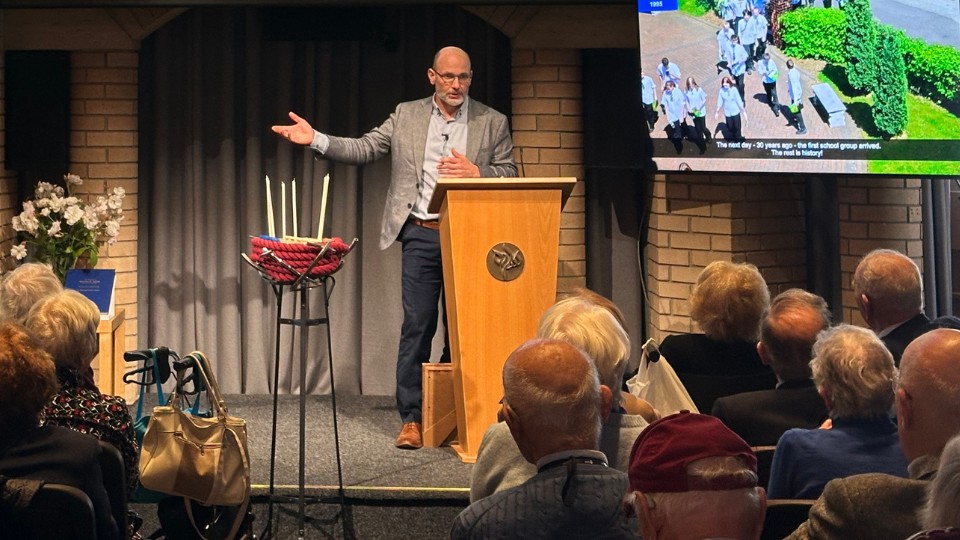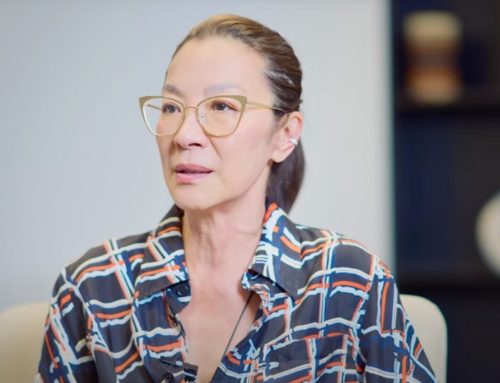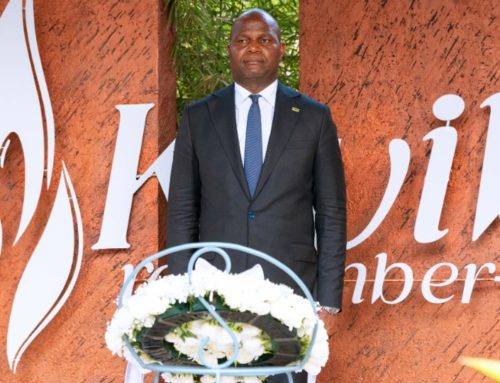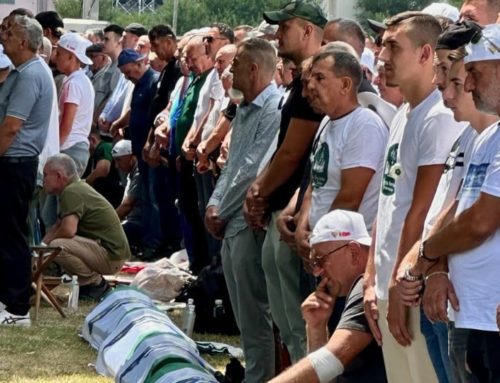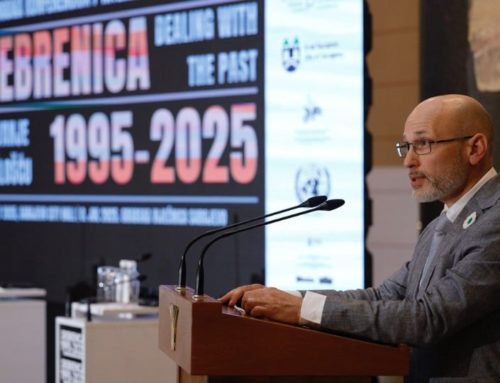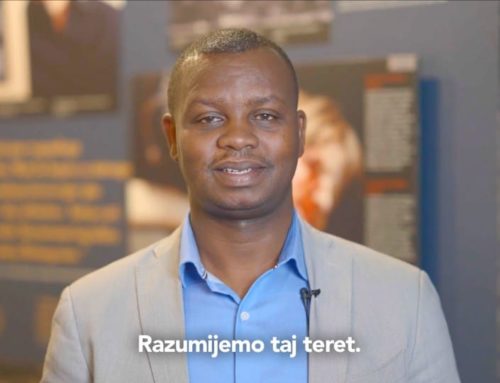On a crisp autumn Sunday in Nottinghamshire, this past weekend Holocaust survivors, supporters, staff, volunteers and trustees gathered at the UK National Holocaust Museum to mark an extraordinary milestone: thirty years since the doors first opened in September 1995. For those of us at the Aegis Trust, this anniversary holds profound significance – Beth Shalom, as the museum was originally known, is not just our organisational birthplace, but the foundation on which our global mission to prevent genocide was built.
From a Taxi Driver’s Challenge to a Global Mission
Co-founder Dr Stephen Smith took the audience on a moving journey through memory lane, sharing rarely-seen photographs and stories from the museum’s origins. The catalyst for everything that followed came in 1991, during a summer at the Hebrew University in Jerusalem. After visiting Yad Vashem with his brother James, the two young men found themselves in a taxi on Har Herzl, discussing what they’d witnessed.
“We said there needs to be a place in Europe where people can go to learn about the Holocaust,” Stephen recalled. The Israeli taxi driver, Josh Turgeman, stopped at a red light, turned around and issued a simple challenge: “You do it.”
That moment of determination led the brothers back to their parents’ retreat centre in rural Nottinghamshire. They asked Eddie and Marina Smith if they could transform Beth Shalom into something unprecedented: the world’s only Holocaust centre founded by a Christian family.
“They said, “Of course, boys”,” Stephen remembered. “And then we began the journey together.”
Drawing Lines in Challenging Times
Three decades later, co-founder Dr James Smith delivered a powerful reflection on the museum’s enduring relevance, drawing parallels between history and our present moment. His speech centered on the German Confessing Church and its leader Martin Niemöller – not as the liberal figure often imagined, but as a conservative nationalist and self-confessed antisemite who nevertheless drew a crucial line.
“The Confessing Church wasn’t opposing the Nazis because they had a distaste for centuries-old anti-Jewish hatred,” James explained. “Many of them were sympathetic. Many of them were antisemitic. But they drew a line at the racialization” – at the Nazi Aryan paragraph that excluded Jews from the church even though they were Christians.
James’s insight was profound: “Those who are closest to the extremists ideologically are those that often have the greatest leverage and power to draw a line and stop what’s taking place.”
Referencing a recent article by Michael Gove comparing our times not to Nazi Germany but to the Weimar Republic, James warned of growing polarization, misinformation and conspiracy theories. “We live in a polarized world,” he said. “Every day there are new divisions about something. The more that we become polarized, the more that we feel under siege, there’s a greater possibility that we will erode our own humanity and our own empathy.”
His appeal was both urgent and hopeful: that “when we know in our hearts that a line must be drawn, we do what we can to find that courage to draw that line early and draw it hard.”
From Roses to Thorns: Evolution of a Mission
The anniversary celebrations showcased how the museum has evolved. Director Marc Cave explained the significance of the museum’s new rose logo: “We changed our logo to a rose not just because of the memories that they hold, but because of the thorns which protect those roses and allow them to rebloom each year.”
This metaphor captures the museum’s transformation. While maintaining its core commitment to survivor testimony and Holocaust memory, the institution now employs cutting-edge pedagogy to tackle contemporary challenges. Director of Learning Nicola Strouther outlined new programmes that address critical gaps in young people’s understanding – from comprehending both the religious and ethnic dimensions of Jewish identity, to recognising the same conspiracy theories that appear in both 1930s Nazi propaganda and today’s social media.
The museum has also taken its work beyond its walls. Professor Maiken Umbach described touring exhibitions like ‘The Vicious Circle,’ which explores five anti-Jewish pogroms across history to show how violence against Jews is incited. When the exhibition was shown in inner-city Berlin, 700 students from a German-Arabic school viewed it, their institution subsequently calling for it to be included in Germany’s national curriculum.
“We are reaching internationally as well as nationally,” Marc emphasized, “and we are having conversations that many people do not want to have.”
A Legacy That Continues
Perhaps the most poignant moment came when Stephen presented the Marina Smith Memoirs – 52 volumes meticulously documenting the museum’s first 25 years, compiled by his late mother. “My mother was a great documentarian,” he said with obvious affection. “You’re all in here, by the way. Many times over.”
The event also honoured survivors with a special gift – white rose bushes from the museum’s memorial garden, to be planted in their own gardens. “You have carried the weight of history with grace and determination,” Stephen told them. “Your dedication has transformed personal tragedy into a beacon of hope.”
As we at Aegis Trust reflect on thirty years of the UK National Holocaust Museum, we see not just the past but a roadmap for the future. The museum’s evolution from a place of memory to an active force challenging hate, conspiracy theories and polarization mirrors Aegis’s own expansion from Holocaust education to genocide prevention internationally.
The Smith brothers’ vision, sparked by a taxi driver’s challenge in Jerusalem, has grown into something neither could have fully imagined in 1991. From Beth Shalom emerged not only the UK’s National Holocaust Museum but the Aegis Trust itself – now working in Rwanda at the Kigali Genocide Memorial and beyond through the newly-launched Isōko Centre for Humanity.
As James concluded his anniversary address: “The work of this museum is doing everything it can in these challenging times. The leadership, the staff, your stories and your commitment is always what fills me with hope.”
For all of us at Aegis, that hope – grounded in memory, strengthened by education, and expressed through action – remains the foundation of everything we do.
To learn more about the UK National Holocaust Museum’s work, visit holocaust.org.uk. Stephen Smith’s new YouTube series “Life’s a Journey” documents the museum’s history and is available here.

